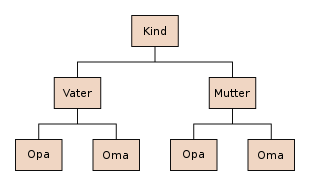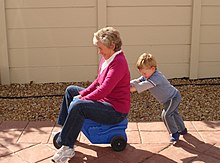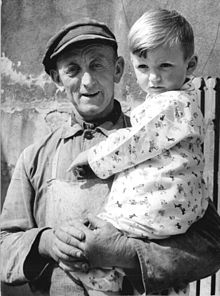Grandparent
![]()
Grandfather is a redirect to this article. For the rock see Grandfather (Devil's Wall), for the dance song Grandfather Dance.
Grandparents refers to a person's 2nd generation of ancestors: the parents of their parents, two grandmothers and two grandfathers, also called grandma and grandpa, belittling granny and grandpa:
The person, in turn, is a grandchild of these grandparents, between them there is a gap of 2 generations (indicated by the prefix grand-). Legally, grandparents are relatives of the second degree (two "mediate births"). As soon as a person has own children and children's children (grandchildren), he is a grandparent himself. Grandparents are divided into patrilateral and matrilateral relatives.
All grandparents, parents, children and grandchildren of a person are related to each other in a direct, "straight line" because one is biologically descended from the other (consanguinity), or because they are legally recognized (adoption, paternity acknowledgment, birth after foreign egg donation).
In addition to genetically related grandparents, there are also step-grandparents and social grandparents, for example the foster parents of a parent, or a nominal grandparent chosen by themselves in a circle of friends or neighbours (elective relatives), or a professional "surrogate grandmother" as a carer (see below on social grandparenting). A step-grandparent may be the stepparent of a parent, or a parent of a stepparent, or a stepparent of a stepparent.
A person has less than 4 grandparents if their parents are (half-)siblings (see also Sibling Marriage, Ancestral Attrition) - or more than 4 in the case of adoption, because there are then other legal grandparents besides the biological ones.
The parents of the grandparents are the great-grandparents (see generation names), the siblings of grandma or grandpa are great-aunts and great-uncles. Other children of the four grandparents are uncles and aunts, siblings of their own parents.

Sequence of three generations on a traditional pedigree chart
_Wilhelm_Nitzschke_Stuttgart_(1).tiff.jpg)
The grandmother in the circle of her grandchildren (unknown artist, around 1860)
Designations
The words grandfather and grandmother are equivalents of the French grand père and grand mère; they have supplanted the earlier terms Ahne, Ahnl or Ähnl, which are still common in Alpine German. In southern German Omama and Opapa are common, and in Luxembourgish Boma and Bopa. With the "O" or the "A" (Ä) as an abbreviation for formerly alder, elder, older are meant the "older" dad and the "older" mom.
In Swiss German, Grossmueter and Grossvatter were the most common in the first half of the 20th century (Swiss spelling with double s), in Bernbiet the grandfather was called Grosätti and Groosatt. Today, Grossmami or Grosi and Grosspapi are used more frequently than in the past. Due to the influence from Germany, grandma and grandpa are on the rise. In Graubünden and in the south of the canton of St. Gallen, where Rhaeto-Romanic used to be spoken, grandmothers are still referred to as Aani or Naani and grandfathers as Eni or Neni.
In Low German, the terms Ellermutter (Eldermutter) for the grandmother and Eldervater for the grandfather are also common. Ellermutter also became known outside Low German through the Grimm fairy tale Der Teufel mit den drei goldenen Haaren (The Devil with the Three Golden Hairs).
In some languages, for example High Chinese, Danish and Swedish, there are different names for the paternal and maternal grandparents. In Denmark and Sweden, the mother's mother and father are called mormor (mother's mother; mother's mother) and morfar (mother's father; mother's father) respectively, and the father's mother and father are called farmor (father's mother; father's mother) and farfar (father's father; father's father) respectively.
Social grandparenthood
The designation as grandma or grandpa is sometimes also used colloquially by children for unrelated older persons (nominal grandma or grandpa as elective relatives). A "Leihoma" is an older woman who, for pay, temporarily cares for children of other families and engages in activities with them as a grandmother normally does (see also foster parents); there are Leihoma agencies for their placement. The Austrian television series Der Leihopa already told stories of a granny agency in the 1980s. The term Patenoma/Patenopa (godmother/grandparent) is also widespread, especially for those who work on a purely voluntary basis.

The singer Charmiane Neville with her grandson (concert in New Orleans 2009)
Social role of grandparents
Research showed different forms of grandparenting depending on the gender of the grandparent, the physical distance, the age of the grandchildren, crisis situations such as a divorce of the parents, and the attitude of the parents towards the grandparents.
Commitment to the care of grandchildren
Grandparents play an important role in raising and supervising grandchildren in many cultures. As industrialized nations experience longer life spans for individuals, as well as declining birth rates and thus an increasing proportion of older individuals in the total population, the study of the role of grandparents in child rearing is of increasing interest. There is a tendency for maternal grandparents to provide greater support, and lower geographic distance is usually associated with greater grandparental support. Several studies show a positive effect of grandparent care on grandchildren's language acquisition.
Grandparents provide important support, especially in times of crisis such as unemployment, accidents or chronic illness, through practical help and emotional care. If parents are no longer available to raise their children, grandparents are most often found below kinship foster parents.
Single parents in particular have grandparents to assist them. Data from the Survey of Health Ageing and Retirement 2010 from 16 states show that single parents receive more time-intensive childcare support from their parents than parent couples. The role of grandparents is also considered very important in supporting parents of children with disabilities. In individual cases, with regard to grandparents of disabled children, it is noted that parents perceive the influence of grandparents as interference or as being overly concerned, or think that grandparents are too unsympathetic to the difficulties of parents. Society often offers little help to grandparents in fulfilling their role.
It is predominantly grandparents from the middle and upper classes who engage in this form of "active grandparenting". According to a 2018 study by the German Youth Institute, the frequency of contact with parents also depends on age and marital status: younger grandparents are more likely to have at least weekly contact with their grandchildren than older ones (grandparents aged 40-54: 84%; 55-69-year-old grandparents: 79%; older ones: 61%), and grandparents in couple relationships see their grandchildren more often than single grandparents, although this is particularly true of grandfathers.
Germany
According to the results of a survey published in 2002 by the German Centre of Gerontology (DZA), almost one in five Germans aged between 40 and 85 regularly looks after their grandchildren. (See also: Elternhauserziehung in Deutschland#Elternhaussituation).
As grandparent leave, working grandparents are legally entitled to time off work to care for grandchildren under certain circumstances.
Care by grandparents is not supported by the Youth Welfare Office, or only to a limited extent; however, the costs of care, including travel costs, can under certain circumstances be claimed as childcare costs for tax purposes. If grandparents (or another person) look after a child under the age of three who does not attend a day care centre and is not looked after within the framework of day care, the parents are entitled - within certain time limits - to the childcare allowance.
Within the family, the older generation supports the following generations by taking care of the grandchildren and by making gifts. In the middle class, grandparents also partly contribute to the financing of education for their grandchildren, such as the costs of private schools, stays abroad or universities of excellence.
Since the reform of the law of parent and child on 1 July 1998, grandparents have a right to contact with the grandchildren on the basis of section 1685 of the Civil Code, provided that it is established by a court that this is in the best interests of the child. It is assumed that it is good and beneficial for the child if existing interpersonal relationships are continued, and there is a legal presumption that the child's contact with its own parents serves the child's welfare. However, this presumption may be rebutted if the child faces a significant conflict of loyalties due to existing conflicts between parents and grandparents. For example, in a 2017 ruling, the Federal Supreme Court stated that "contact between the grandparents and the child regularly does not serve the child's best interests if the parents - who reject such contact - and the grandparents are so at odds that the child would be placed in a conflict of loyalties if they had contact".
Switzerland
According to a survey from Switzerland, the amount of family work done by grandparents is approximately 100 million hours per year, which is significantly higher than that of all Swiss primary school teachers. The relationships are characterized by "camaraderie, shared emotionally satisfying activities, and voluntary mutual assistance.
United States
In the United States, half of all grandparents were under age 60 in 1995 and a quarter were under age 55. From 1970 to 1997, there was a marked increase in the number of households headed by a grandparent. Of these households, two-thirds were three-generation households in 1997. In the remaining third, no parent resided; this was often related to divorce, drug addiction, mental illness, incarceration, or parental death. Studies show that grandparents experience it as stressful when they have to assume full parenting responsibility for their grandchildren in such cases.
During the day, 16% of all preschool children in the United States are cared for by their grandparents.
Other countries
As part of the Survey of Health, Ageing and Retirement in Europe (SHARE), people over the age of 50 who had grandchildren under the age of 15 were asked in eleven European countries and in Israel to what extent they cared for grandchildren. More than 60% of the grandmothers and almost half of the grandfathers surveyed had looked after a grandchild at least once in the previous year. According to the results of a study organised by the Vienna Institute of Demography (VID), among others, grandparents in northern European countries generally look after children only occasionally - while children in southern European countries are looked after by grandparents on a regular weekly basis. This international variation is demonstrably related to the availability of childcare places for (young) children: where there is quantitatively sufficient and high-quality state childcare, grandparents look after their grandchildren occasionally. Where these are lacking, however, grandparents care for the (grand)children regularly and time-intensively.
In African and Caribbean countries, many children live with their grandparents. This is often because the parents move to a distant city for work, or because they can no longer fulfil their parental responsibilities due to AIDS (or death). According to data from nine African countries, the likelihood of children being raised by their grandparents increases in countries with a high incidence of HIV. High rates of orphans living with their grandparents are also reported in Latin American, Asian and Caribbean countries. In Thailand and South Africa, this affects about half of AIDS orphans.
grandparent-grandchildren relations
In a survey in Switzerland, over 90% of the grandchildren and grandparents interviewed described their relationship with each other as important. The majority of grandchildren characterized their grandparents as loving and generous, a minority as strict and impatient. Grandparents being there for their grandchildren, listening to them, and having time for them were cited as especially valuable. The survey of the grandchildren revealed that a relatively good physical and mental health of the grandparents was necessary for a lively relationship and that this was more important than their actual age.
At the end of the 1980s, studies of about 400 grandparents, parents and grandchildren of all ages showed that the decisive factor for satisfaction with the grandparent-grandchild relationship and the intensity of this relationship was not so much the frequency of contact per se as sufficient contact in private. Emotional support, including cuddling and trusting conversations, the lack of pressure to perform, the absence of a parenting mandate, the time available and the grandchildren's unreserved acceptance were highlighted as important positive factors.
Peter Schwob claimed in 1988 that grandparents perform the function of "quadrangulation" in family events, the inclusion of a fourth person in the father-mother-child relationship network, in analogy to the function of "triangulation" by the father in relation to the mother-child relationship. It helps the grandchild to detach himself from the parents and at the same time allows him to recognise that this does not have to mean the dissolution of family ties. At the same time, it enables the grandchild to put the role of the parents into perspective.
At the same time, the grandchild's parents have a kind of guardian function: they exert a strong influence on the nature and intensity of the grandparent's relationship with the grandchildren.
During puberty, the relationships between grandchildren and their grandparents are often not subject to the same fluctuations and conflicts as parent-child relationships. Grandparents are sometimes particularly important caregivers for their grandchildren during this time. According to a 2018 study by the German Youth Institute, young people want to be taken seriously by their grandparents, but do not want to talk to them about intimate topics of growing up.
Grandparents provide their grandchildren with a glimpse of family history and often serve as role models.
If the grandparents live abroad, there is usually little contact and joint activities, despite the importance attached to the relationship. In this case, they mainly take place in the form of digital communication, visits or holidays. Above all, grandchildren from migrant families would like more frequent contact with their grandparents.
Legal
Adopted children are equal to natural children and thus have legally the same degree of relationship to their grandparents.
Grandparents do not have their own visitation rights of their grandchildren in many states, for example in the USA. Thus, parents can deny their grandchildren contact, for example if the parents divorce or if there is conflict between the parents and grandparents. However, there is provision for consideration of the best interests of the child.
If grandchildren and grandparents live in different states, there may be strict limits to the grandparents' involvement, since as a rule their relationship does not give rise to a right to family reunification. For example, in Germany, according to the General Administrative Provisions on the Residence Act, the subsequent immigration of underage grandchildren to a grandparent "can only be considered if they are orphans [...] or if the parents are demonstrably no longer able to exercise personal care in the long term (e.g. due to a need for care)."
Role expectations
Due to the longer life expectancy of women, mothers and grandmothers are present longer than fathers and grandfathers, resulting in a "feminisation of familial generational relationships" in the second half of life.
Grandparenthood, especially grandmotherhood, is a family role in old age with a positive connotation today, but at the same time strongly influenced by stereotypes. At the same time, in social reality grandparents are often confined to a clearly defined "holiday existence" with limited competencies, which counteracts a possible competitive situation with the mother. There is a model of a "loving and understanding grandmother", whereby the bourgeois conception at the same time points to an asexual and rather tolerant person (on the role of the grandmother, see also grandmother hypothesis).

Granny plays with her grandson

A farmer with his grandchild (Propaganda picture of the GDR 1957, Federal Archive)
Questions and Answers
Q: What does the term 'grandparent' mean?
A: The term grandparent refers to the parents of a person's father or mother.
Q: How is the role of a parent different from that of a grandparent?
A: Parents are typically responsible for providing and disciplining their children, while grandparents often have more freedom to enjoy and have fun with their grandchildren.
Q: Is the term 'grandparent' used for both male and female genders?
A: Yes, the term 'grandparent' is used for both male and female genders. The male grandparent is called a grandfather, while the female grandparent is referred to as a grandmother.
Q: What is another name for a person's child's child?
A: A person's child's child can also be referred to as their grandchild.
Q: Is there different terminology based on gender when referring to grandchildren?
A: Yes, when referring to grandchildren based on gender, "grandson" is used for males and "granddaughter" is used for females.
Search within the encyclopedia